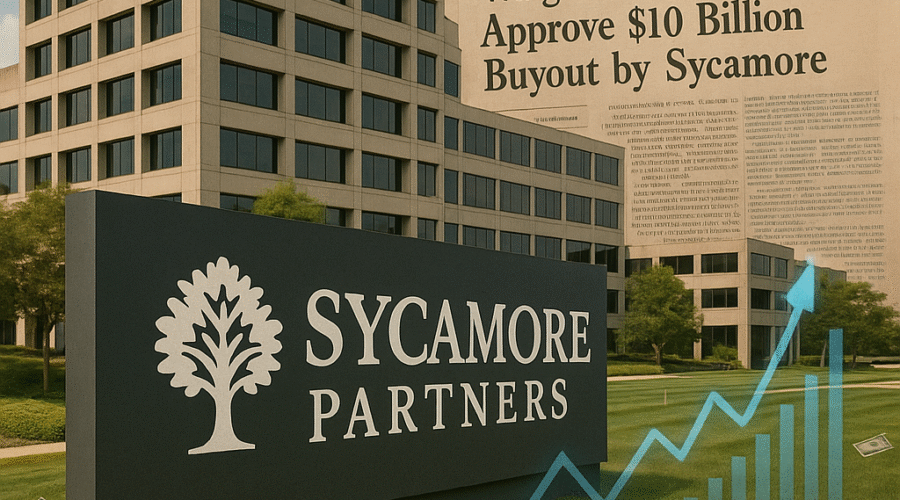The $10 billion acquisition of Walgreens Boots Alliance by Sycamore Partners represents one of the largest leveraged buyouts in recent retail pharmacy history, approved by 96% of shareholders in July 2025. This transaction—valued at up to $23.7 billion including debt—marks the end of Walgreens’ 122-year public market tenure amid a 90% stock decline since 2015. Shareholders will receive $11.45 per share plus contingent rights to $3.00 from VillageMD asset sales, while Sycamore inherits a turnaround challenge involving 1,200 store closures, $9 billion debt, and strategic repositioning in a volatile pharmacy sector. The deal’s 83.4% debt financing structure and regulatory hurdles ahead signal high-stakes execution risks for the private equity firm[1][4][8][12].
💼 Seasoned CorpDev / M&A / PE expertise
Transaction Architecture and Shareholder Value Proposition
Deal Structure and Financial Mechanics
Sycamore Partners’ acquisition employs a two-tiered compensation model for Walgreens shareholders. The immediate cash component of $11.45 per share represents a 29% premium to Walgreens’ December 2024 stock price, while the non-transferable Divested Asset Proceeds Right (DAP Right) entitles holders to up to $3.00 per share from future monetization of VillageMD assets. This structure brings the total potential consideration to $14.45 per share—a 63% premium to pre-rumor trading levels. The bifurcated payout shifts execution risk to shareholders, as the DAP Right’s value hinges on Sycamore’s ability to profitably divest VillageMD’s portfolio of 345+ clinics, which some analysts value below the $3.4 billion Walgreens projection[1][8][12][14].
Financing Composition and Leverage Concerns
Debt constitutes 83.4% of the transaction’s financing structure—more than double the 41% average for 2024 private equity buyouts—with Sycamore securing commitments from over a dozen lenders. This aggressive leverage strategy raises sustainability questions given Walgreens’ existing $9 billion debt burden and ongoing opioid-related liabilities. The Private Equity Stakeholder Project warns that such debt levels typically drain resources from innovation and workforce development, potentially undermining the very turnaround Sycamore intends to execute. Notably, Walgreens suspended its dividend in 2024 to conserve cash, eliminating a key income stream for former shareholders while increasing pressure on operational cash flow to service the expanded debt load[1][8][12].
Shareholder Sentiment and Market Dynamics
Overwhelming Approval and Investor Rationale
The 96% shareholder approval rate reflects strategic resignation rather than enthusiasm, with the $11.45 cash component representing modest relief after years of erosion. Long-term investors faced the dilemma of accepting a fraction of Walgreens’ former $100 billion valuation versus risking further decline under continued public ownership. The 8% premium to pre-announcement trading levels paled against the 63% premium to December 2024 prices, revealing that Sycamore effectively paid for the stock surge its own interest created. This dynamic underscores the absence of alternative catalysts to revive shareholder value, making approval a pragmatic exit strategy for disillusioned investors[1][4][7][15].
Market Reaction and Sector Implications
Initial deal rumors in December 2024 triggered a 63% stock surge, while the March 2025 announcement prompted a 6% after-hours jump to $11.38—just below the $11.45 offer price. This trajectory demonstrates how private equity interest became Walgreens’ primary value driver amid sector-wide headwinds. Pharmacy peers face parallel challenges: CVS plans 270 store closures in 2025 after shuttering 900 locations, while Rite Aid emerged from bankruptcy after closing 800 stores. Nearly one-third of independent pharmacies risk closure within the year, indicating structural industry pressures that made Walgreens’ take-private inevitable[2][7][11].
Strategic Imperatives for Walgreens Under Private Ownership
Addressing Core Business Challenges
Walgreens’ operational struggles necessitated radical intervention: declining front-end sales, unfavorable pharmacy reimbursements, and failed healthcare ventures eroded profitability. Sycamore must execute the previously announced closure of 1,200 underperforming stores while renegotiating thousands of commercial leases—a process complicated by real estate investors holding Walgreens-leased properties. The suspension of Walgreens’ dividend in 2024 signaled capital preservation priorities that align with Sycamore’s need to redirect cash flow toward debt service, though this eliminates a traditional shareholder return mechanism[1][7][8].
Healthcare Asset Divestiture Strategy
Sycamore inherits Walgreens’ troubled $6.2 billion investment in VillageMD, which expanded to 345+ locations before Walgreens closed 160 clinics in 2024. The DAP Right structure makes VillageMD monetization urgent, though market valuations suggest Sycamore may struggle to achieve Walgreens’ projected $3.4 billion return. Private equity firms TPG and Warburg Pincus previously invested in VillageMD, creating potential exit pathways, but industry experts like Georgetown’s Sandeep Dahiya suggest $1 billion represents a more realistic valuation. Successful divestiture is critical not only for shareholder payouts but also for simplifying Walgreens’ operational focus to core pharmacy and retail[8][12].
Sycamore Partners’ Turnaround Playbook
Private Equity Expertise in Retail Transformation
Sycamore brings specialized experience from turnarounds of Staples, Belk, and Hot Topic—retail brands facing analogous digital disruption and margin compression. The firm’s playbook typically involves portfolio simplification, cost rationalization, and operational recalibration away from quarterly earnings pressure. For Walgreens, this means accelerating Tim Wentworth’s existing turnaround strategy while leveraging Sycamore’s expertise in real estate optimization, supply chain efficiency, and brand repositioning. The multi-year hold period provides breathing room for fundamental restructuring before potential re-IPO or strategic sale[6][8][11].
Leadership Continuity and Cultural Integration
CEO Tim Wentworth will remain at the helm during the transition, signaling Sycamore’s intent to maintain operational continuity while injecting private equity discipline. The retention of Walgreens’ Deerfield, Illinois headquarters and consumer brands (including Boots and Duane Reade) aims to preserve customer loyalty during ownership transition. However, Sycamore must navigate cultural integration with Walgreens’ 311,000 global employees amid inevitable restructuring—a challenge compounded by pharmacy sector labor shortages and high turnover rates[4][9][14].
Industry Implications and Competitive Landscape
Pharmacy Sector Consolidation Trends
Walgreens’ take-private accelerates pharmacy retail’s consolidation, mirroring Rite Aid’s bankruptcy restructuring and CVS’ store optimization program. The transaction validates private equity’s appetite for distressed pharmacy assets, though Sycamore’s premium debt load may deter imitation. Amazon’s pharmacy expansion and Mark Cuban’s Cost Plus Drugs model intensify margin pressure, forcing traditional players toward vertical integration or niche specialization. Independent pharmacies face existential threats from reimbursement challenges and scale disadvantages, with 30% at risk of closure within 12 months[2][8][11].
Healthcare Services Retreat
Walgreens’ exit from primary care via VillageMD divestiture signals retreat from the “retail-as-clinic” model that defined its 2019-2024 strategy. This pivot contrasts with CVS Health’s continued investment in MinuteClinic and Aetna integration, suggesting divergent sector strategies. The failed VillageMD experiment—which abandoned plans for 600+ clinics after $6.2 billion in investments—may cool private equity enthusiasm for hybrid pharmacy/healthcare models, particularly given Medicare reimbursement uncertainties and rising labor costs[8][12].
Execution Risks and Regulatory Hurdles
Debt Servicing and Cash Flow Challenges
The transaction’s 83.4% debt financing creates immediate cash flow pressure, requiring $300-$400 million in annual interest payments before principal repayment. This burden coincides with Walgreens’ need to fund: 1) store closure costs, 2) opioid litigation settlements, and 3) technology investments to compete with Amazon and digital pharmacies. Sycamore must achieve 4-6% same-store sales growth while reducing operating costs by 15% to meet lender covenants—targets complicated by pharmacy reimbursement cuts and front-end margin erosion[1][8][12].
Regulatory Scrutiny and Closing Timeline
Despite shareholder approval, the transaction faces Federal Trade Commission (FTC) review amid heightened antitrust scrutiny of healthcare transactions. The involvement of Kirkland & Ellis as legal advisor and Ropes & Gray as healthcare regulatory counsel signals anticipated challenges. Walgreens projects Q3-Q4 2025 closing, but FTC concerns about Sycamore’s ownership of competing healthcare assets could extend review. Failure to secure regulatory approval would trigger a $750 million termination fee payable to Sycamore—a material risk given current administration’s stance on private equity healthcare ownership[4][5][9].
Conclusion: Strategic Crossroads for an Iconic Brand
Sycamore Partners’ acquisition rescues Walgreens from public market pressures but introduces substantial execution risks through aggressive leverage and complex restructuring. The firm must simultaneously: divest healthcare assets at acceptable valuations, rationalize Walgreens’ physical footprint amid digital disruption, and service unprecedented debt levels—all while navigating regulatory scrutiny and sector headwinds. Success would validate private equity’s role in retail pharmacy transformation, while failure could accelerate the sector’s consolidation. For 311,000 employees and millions of daily customers, this transaction represents not merely an ownership change, but a last-best chance to reposition a 122-year-old institution for sustainable
Sources
https://investmentgrade.com/walgreens-takeover-investment-grade/, https://source.washu.edu/2025/03/washu-experts-what-walgreens-10-billion-private-equity-deal-means-for-consumers-pharmacy-industry/, https://investor.walgreensbootsalliance.com/sycamore-transaction, https://www.businesswire.com/news/home/20250711500991/en/Walgreens-Boots-Alliance-Shareholders-Overwhelmingly-Approve-Transaction-with-Sycamore-Partners, https://www.stocktitan.net/news/WBA/walgreens-boots-alliance-shareholders-overwhelmingly-approve-oszxioofnasy.html, https://www.youtube.com/watch?v=jAC7vXVaxw4, https://www.investopedia.com/walgreens-agrees-to-be-taken-private-in-usd10b-deal-11692686, https://www.aha.org/aha-center-health-innovation-market-scan/2025-03-18-walgreens-move-go-private-4-key-takeaways, https://investor.walgreensbootsalliance.com/news-releases/news-release-details/walgreens-boots-alliance-enters-definitive-agreement-be-acquired/, https://www.stocktitan.net/news/2024-11-29/, https://healthexec.com/topics/healthcare-management/mergers-and-acquisitions/private-equity-firm-buy-walgreens-10b-report-claims, https://www.businesswire.com/news/home/20250306492146/en/Walgreens-Boots-Alliance-Enters-into-Definitive-Agreement-to-Be-Acquired-by-Sycamore-Partners, https://investor.walgreensbootsalliance.com/sycamore-transaction/, https://drugstorenews.com/walgreens-boots-alliance-shareholders-approve-pending-sycamore-partners-acquisition, https://www.investing.com/news/company-news/walgreens-shareholders-approve-1145-per-share-sycamore-buyout-93CH-4132217, https://investor.walgreensbootsalliance.com/news-releases/news-release-details/walgreens-boots-alliance-shareholders-overwhelmingly-approve, https://www.stocktitan.net/sec-filings/WBA/defa14a-walgreens-boots-alliance-inc-additional-proxy-soliciting-mate-f93437d6914a.html





